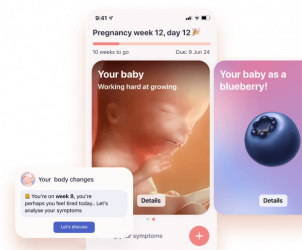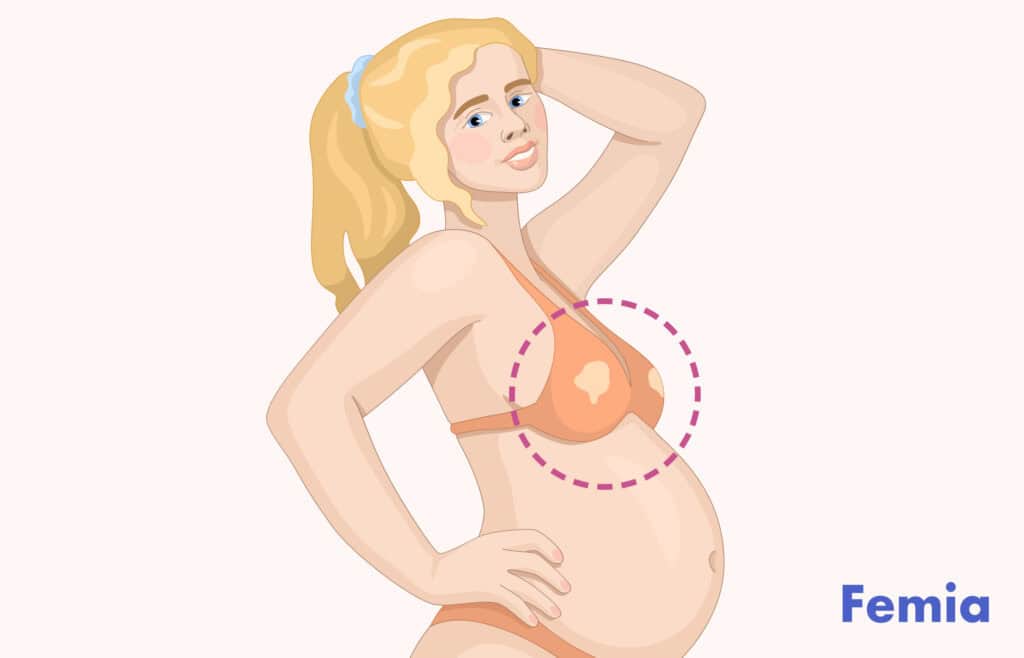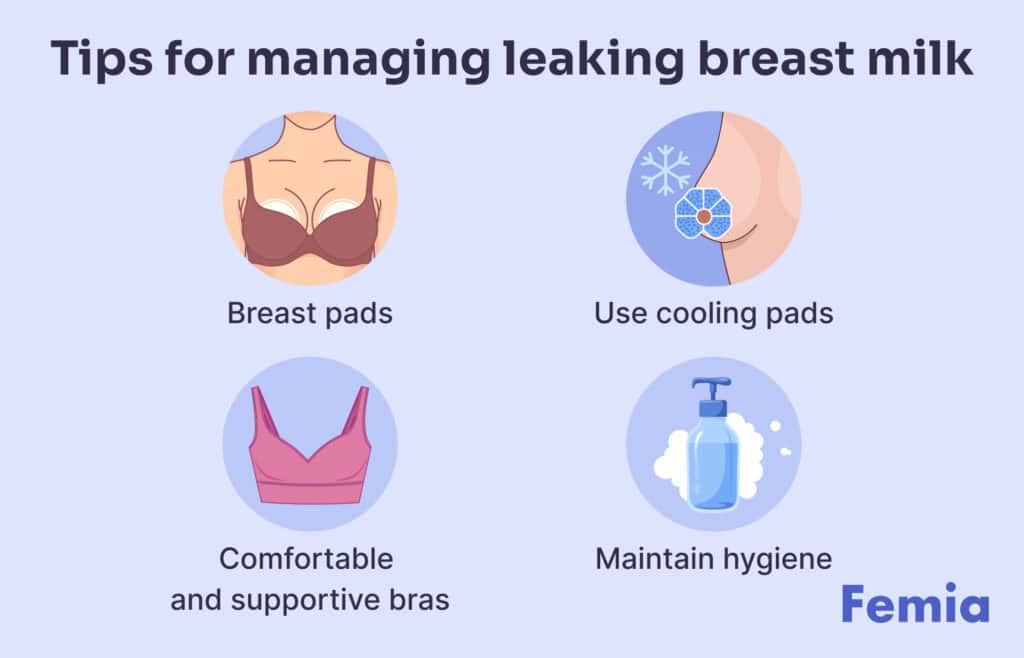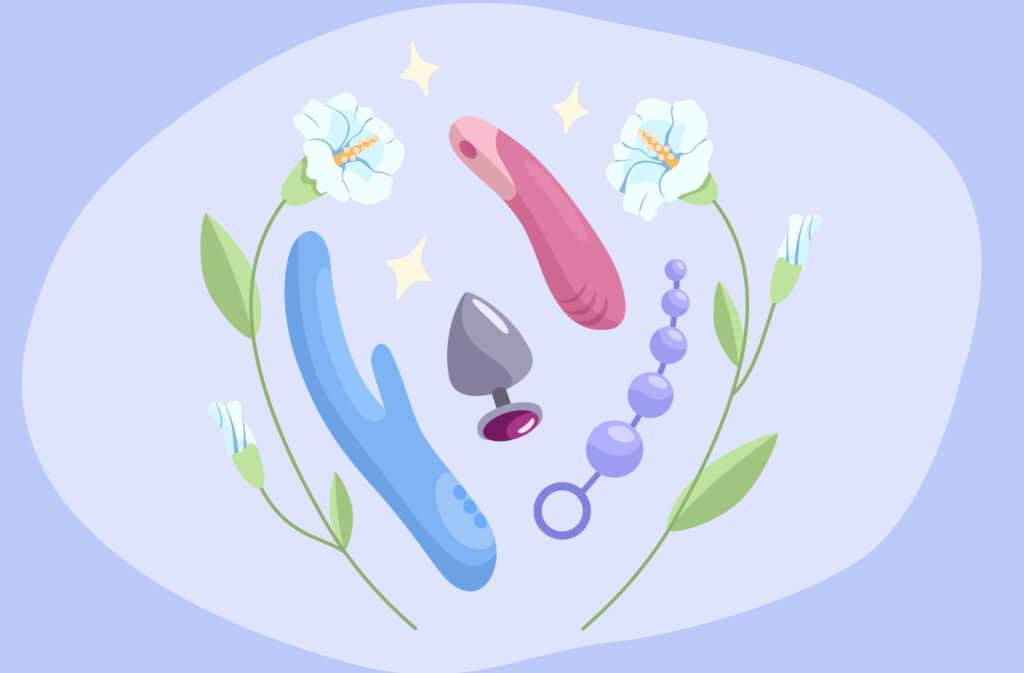Femia > Health Library > Pregnancy > Pregnancy health > Understanding lactation: Signs your milk is coming in during pregnancy
Understanding lactation: Signs your milk is coming in during pregnancy

- Updated Mar 2, 2025
- Published
CRAFTED BY HUMAN
Crafted by human At Femia, we provide accurate and up-to-date information at every stage of your journey, from trying to conceive, pregnancy and postnatal support. All content is created by a real person based on in-depth research and own professional experience. Femia ensures that you will receive expert advice, strict accuracy and a personalized approach from our authors/medical experts. Learn more about our editorial policy.
FACT CHECKED
Fact checked At Femia Health, we maintain the highest standards of editorial excellence in delivering content focused on helping you conceive, guiding you through pregnancy, and supporting you postpartum. Explore our content review principles to learn how we ensure the accuracy and quality of our health and lifestyle tips for every stage of your journey.
Breast milk can start coming in as early as the second trimester, in preparation for your baby’s arrival. You may notice breast tenderness, fullness, and changes in the size of your breasts and nipples along with leaking from your nipples—all signs indicating preparations your body is making to produce breast milk. The first milk you will notice is colostrum, which changes to mature milk postpartum.
As your pregnancy progresses, you might have already started preparing the essentials to breastfeed your baby and wondering whether your breast milk has started coming in. Signs that your breasts are ready for lactation, such as milk leaks during pregnancy, can begin as early as your second trimester. The types of breast milk you make will go through stages, with the primary ones taking place postpartum.
When milk starts coming in, you will notice several changes in your breasts. In addition to having to change your bra size every few weeks, your breasts will feel sore and heavy. You may also notice stains of leaking breast milk on your bra. This process is a natural part of pregnancy and looks different for all women throughout pregnancy.

What are the signs that the milk is coming in during pregnancy?
Most of the significant signs of breast milk coming in and transitioning to mature milk are noticed during your postpartum phase. The delivery of the placenta and a significant drop in progesterone work as a signal to increase your breast milk production. However, during pregnancy, your breast tissue prepares ahead of time for lactation. A few signs milk is coming in during pregnancy include:
- Breast tenderness and swelling: As your body prepares the essentials for nourishing your baby, you will notice an almost overnight increase in your breast size, warranting regular changes to a bigger bra. To facilitate milk production, the glands and ducts in your breast will increase in size as well. The size and circulating hormones can worsen breast soreness during pregnancy.
- Nipple and areola changes: Your nipples and surrounding areolas darken throughout pregnancy, starting late in the first trimester. The primary reason is the increase in your pregnancy hormones. However, with the increase in breast tissue, these changes will become more prominent.
- Leaking milk: You may start noticing yellow or orange stains on your bra starting from your second trimester. This is colostrum, or “first milk,” leaking from your nipples. However, some women may not notice leaking milk during their pregnancy even though milk production has begun. Leaking milk during pregnancy, while a sign of milk coming in, doesn’t have any bearing on how much milk you will make once your baby is born.

@femia.fertility We can help you create a fertility plan based on your needs and health condition. Just check the link in bio. A structured, step-by-step plan can help you feel more in control and less frustrated. You're not alone on your journey ❤️ #ttc #ttccommunity #ttcjourney #ttcover30 #motherin30 #pregnancy #dreambaby #fertilityplan #fertilitysupport #inspiration ♬ sad SpongeBob music - michael
When do pregnant women start lactating?
Breast milk can start coming in as early as the 16th week of your pregnancy, in your second trimester. The surge of pregnancy hormones initiates the secretion of milk from the glands in your breast. While this may be a few drops of milk initially, you may notice more distinct colostrum-consistency milk production toward the end of your third trimester.
Lactation, or the preparation for breastfeeding, essentially begins at conception. This is when your surging lactogenic hormone complex, primarily consisting of progesterone, estrogen, and prolactin, encourages the glands and milk ducts in your breast to grow. This phase is called the secretory differentiation phase, where the cells in your breast differentiate into specialized lactocytes to produce milk once your baby is born. Since these cells start developing early in pregnancy, along with the milk-producing glands in your breast, you may see milk secretion later in your pregnancy, closer to your due date.
Several factors can contribute to whether you leak milk during your pregnancy or not. For one, if you noticed milk leaking during an earlier pregnancy, you are more likely to do so in this pregnancy as well. Your genes, diet, the environment you are exposed to, and how your hormones fluctuate during pregnancy can also contribute to when your milk starts coming in during pregnancy.
Why does milk start leaking during pregnancy?
As described above, the primary reason you may notice milk leaking in the later phases of your pregnancy is due to the consistently elevated levels of hormones such as prolactin, estrogen, and progesterone. While these hormones favor mammary gland growth, they can not determine exactly when your milk might start leaking.
During pregnancy, it’s common to notice only a small amount of milk leaking from your breasts. This can be as little as a few stains on your bra now and then or as much as a significant leak through the bra onto your clothes. It is only after delivery that the drop in progesterone following the release of the placenta favors the production of more milk. Even then, it can take a few weeks for your milk production to optimize based on how quickly you start breastfeeding and how much your baby feeds during the day.
However, it is also possible to go through your whole pregnancy with no signs of leaking breast milk. The primary stage of lactation during pregnancy is the development of the milk-producing glands in your breasts, from which some milk may be secreted. More than milk leaks, you may notice breast soreness, an increase in the size of your breasts, and nipple changes. Not observing milk leaking from your breasts during pregnancy has no impact on the quality and amount of milk you will produce after pregnancy.

What does leaking breast milk look like?
Secreted breast milk during pregnancy is colostrum. This first milk is dark yellow and thick in consistency. Only small amounts of milk might leak from time to time. While it might be more frequent as your pregnancy progresses, especially in the third trimester, it’s rare to notice secreted colostrum regularly staining your clothes during pregnancy.
Colostrum is the same milk that will be expressed from your breast for two to five days following delivery. Often referred to as “liquid gold” because of its deep yellow color, colostrum has a host of health benefits, such as being nutrient-dense and containing immunity-boosting antibodies.

How to manage leaking milk during pregnancy?
You may be caught off guard when you start noticing a few drops of breast milk leaking onto your clothes. While this is completely natural and should be no reason for concern, you still might want to take steps to prevent discomfort because of it.
Here are a few tips that you can use to manage your breast milk leaks during pregnancy:
Use breast pads. Absorbent breast pads can help prevent leaks from seeping onto your clothing at the most awkward moments. You can carry a few of them when you are on the go, to be able to change them out if soaked through.
Comfort and support. Switching and upgrading your bras to provide more support and comfort can prepare you ahead of time for when you start breastfeeding.
Maintain hygiene. Change out wet breast pads regularly to reduce irritation and infection. Ensure you clean your breasts daily and also allow time to air dry without a bra to reduce the risk of yeast, known as Candida infections.
Use cooling pads. If you have excessive soreness on any given day, you can place some cooling pads on your breasts to help reduce the soreness and swelling.
If you notice any out-of-the-norm changes to your breast, such as blistering of the nipples, bloody discharge, dimpling of the skin, or changes in the shape of your nipple, consider checking in with your healthcare provider.

Questions from the Femia community
When does milk start leaking during pregnancy?
You can notice milk leaking as early as the 16th week of your pregnancy, in the second trimester. For some, it is noticed in the third trimester or even after delivery. There is no defined time for when milk might start leaking during pregnancy.
Is it normal not to leak milk during pregnancy?
Yes, it is absolutely normal to have no milk (primarily colostrum) leak from your breasts during pregnancy. Every woman’s body is different, which makes everyone’s changes during pregnancy different as well. So, it is possible to see no colostrum before you deliver. This does not impact the quality and amount of milk you will produce when your baby arrives.
Can I express colostrum before my baby is born?
Yes, it's generally safe to express colostrum before your baby is born, especially if recommended by your healthcare provider. This can help prepare for breastfeeding or if there are concerns about feeding immediately after birth. However, if you have a history of early delivery or are at risk of premature labor, it might not be advisable due to the potential of triggering contractions. Always seek guidance from a healthcare provider or lactation consultant to ensure proper techniques and personalized advice.
Does leaking breast milk mean I will have a good milk supply?
Not necessarily. Leaking breast milk (colostrum) during pregnancy is a hormonal response and doesn't predict your milk supply after childbirth. Successful breastfeeding depends on many factors, including effective nursing techniques, frequency of feeding, and overall breastfeeding support. While leaking colostrum is a positive sign, it's just one aspect of breastfeeding readiness.
I am leaking breast milk, will I go into labor?
Since you may notice your breast milk coming in closer to your due date, it might be an additional sign that you might be going into labor when mixed with occasional contractions and fullness in your pelvis. However, leaking breast milk is not a sure sign of labor. It is one of the host of changes that take place at different intervals for women during their pregnancies. It is best to check in with your OBGYN for a confirmation of labor.
The bottom line
As your pregnancy hormones favor the growth of milk glands and ducts throughout pregnancy, you may notice your milk coming in as early as the 16th week of pregnancy. Milk leaks are completely normal and often increase the closer you get to your due date.
The milk you leak during pregnancy is colostrum, the first milk you’ll produce after delivery. And, it’s important to note that the amount of leaking colostrum you notice during pregnancy has no impact on how much milk you will produce postpartum. If you have any concerns about leaking milk during pregnancy, or lactation in general, check in with your healthcare provider.
References
- Pillay, Jaclyn, and Tammy J. Davis. “Physiology, Lactation.” StatPearls – NCBI Bookshelf, 17 July 2023, www.ncbi.nlm.nih.gov/books/NBK499981.
- Pang, Wei Wei, and Peter E. Hartmann. “Initiation of Human Lactation: Secretory Differentiation and Secretory Activation.” Journal of Mammary Gland Biology and Neoplasia, vol. 12, no. 4, Nov. 2007, pp. 211–21. https://doi.org/10.1007/s10911-007-9054-4.
- Lee, Sooyeon, and Shannon L. Kelleher. “Biological Underpinnings of Breastfeeding Challenges: The Role of Genetics, Diet, and Environment on Lactation Physiology.” Endocrinology and Metabolism/American Journal of Physiology: Endocrinology and Metabolism, vol. 311, no. 2, Aug. 2016, pp. E405–22. https://doi.org/10.1152/ajpendo.00495.2015.
- Boss, Melinda, et al. “Normal Human Lactation: Closing the Gap.” F1000Research, vol. 7, June 2018, p. 801. https://doi.org/10.12688/f1000research.14452.1.
- Poonia, Amrita, and None Shiva. “Bioactive Compounds, Nutritional Profile and Health Benefits of Colostrum: A Review.” Food Production, Processing and Nutrition, vol. 4, no. 1, Oct. 2022, https://doi.org/10.1186/s43014-022-00104-1.

Learn about missed miscarriages, including common causes, symptoms and management options. Understand the causes and how to support your physical and emotional recovery.

After having a baby, it’s normal your sex life changes, especially if you’re breastfeeding. Explore why it does and how to improve your breastfeeding sex.

There are lots of different types of vibrators and it can be difficult to choose. Find out the best vibrator for women and different types of sex toys.

